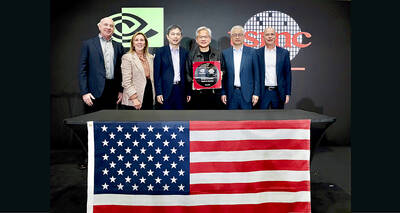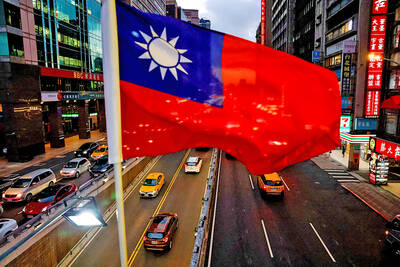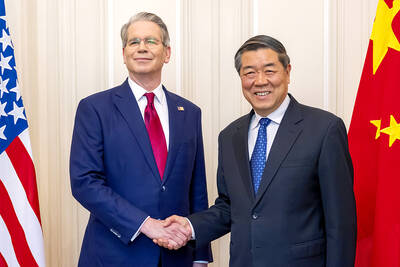Taiwan invested about US$400 million in Vietnam in the first quarter of this year, making it the third-largest source of foreign investment in that nation during the period, according to data from the Vietnamese Ministry of Planning and Investment.
The investments by Taiwanese businesses accounted for 9.6 percent of all foreign investment in Vietnam in the January-to-March period, behind only South Korea, which invested US$513.5 million and had a 12.7 percent share, and Singapore, which invested US$449.3 million and had an 11.1 percent share.
The Vietnamese government approved 473 proposals for new investment by foreign businesses totaling US$2.74 billion and 203 proposals by foreign businesses to expand investment worth US$1.29 billion in the first three months of this year.
The processing and manufacturing sectors drew US$2.98 billion in foreign investment in the three-month period, or 72.2 percent of the total.
The real-estate sector received investments of US$239.8 million, or 5.9 percent of the total.
Foreign capital is flowing into Vietnam because of the creation of the ASEAN economic community which has created a free-trade bloc in the region, economists said.
The Vietnamese government’s pursuit of free-trade deals, including its bid to enter the Trans-Pacific Partnership, has also appealed to foreign investors, economists said.
However, economists are concerned over the nation’s bureaucratic approach to handling foreign investment projects and its poor basic infrastructure, saying that improvements made by the Vietnamese government in these areas have yet to meet the expectations and needs of foreign businesses.

Jensen Huang (黃仁勳), founder and CEO of US-based artificial intelligence chip designer Nvidia Corp and Taiwan Semiconductor Manufacturing Co (TSMC, 台積電) on Friday celebrated the first Nvidia Blackwell wafer produced on US soil. Huang visited TSMC’s advanced wafer fab in the US state of Arizona and joined the Taiwanese chipmaker’s executives to witness the efforts to “build the infrastructure that powers the world’s AI factories, right here in America,” Nvidia said in a statement. At the event, Huang joined Y.L. Wang (王英郎), vice president of operations at TSMC, in signing their names on the Blackwell wafer to

AI BOOST: Although Taiwan’s reliance on Chinese rare earth elements is limited, it could face indirect impacts from supply issues and price volatility, an economist said DBS Bank Ltd (星展銀行) has sharply raised its forecast for Taiwan’s economic growth this year to 5.6 percent, citing stronger-than-expected exports and investment linked to artificial intelligence (AI), as it said that the current momentum could peak soon. The acceleration of the global AI race has fueled a surge in Taiwan’s AI-related capital spending and exports of information and communications technology (ICT) products, which have been key drivers of growth this year. “We have revised our GDP forecast for Taiwan upward to 5.6 percent from 4 percent, an upgrade that mainly reflects stronger-than-expected AI-related exports and investment in the third

RARE EARTHS: The call between the US Treasury Secretary and his Chinese counterpart came as Washington sought to rally G7 partners in response to China’s export controls China and the US on Saturday agreed to conduct another round of trade negotiations in the coming week, as the world’s two biggest economies seek to avoid another damaging tit-for-tat tariff battle. Beijing last week announced sweeping controls on the critical rare earths industry, prompting US President Donald Trump to threaten 100 percent tariffs on imports from China in retaliation. Trump had also threatened to cancel his expected meeting with Chinese President Xi Jinping (習近平) in South Korea later this month on the sidelines of the APEC summit. In the latest indication of efforts to resolve their dispute, Chinese state media reported that

CHINESE EXPORT CURBS: A dispute between China and the Netherlands could halt chip supply, affecting vehicle production, US and European auto associations said Groups representing major automakers late on Thursday warned that a chip disruption stemming from a dispute between China and the Dutch government could quickly affect US auto production. Automakers and their suppliers received notice from chipmaker Nexperia (安世半導體) last week that it could no longer guarantee delivery of its chips, the European Automobile Manufacturers Association said, adding that manufacturing could be significantly disrupted. In the US, the Alliance for Automotive Innovation, which represents General Motors, Toyota, Ford, Volkswagen, Hyundai and nearly all other major automakers, urged a quick resolution. “If the shipment of automotive chips doesn’t resume — quickly — it’s going to